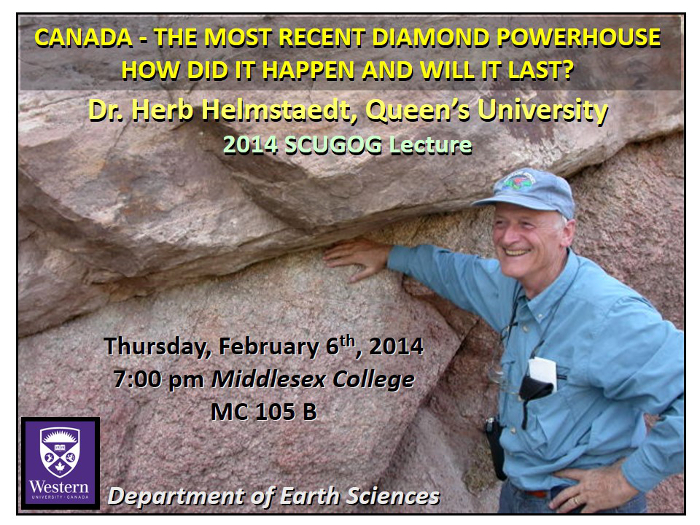2014 SCUGOG Lecture
The Department of Earth Sciences, Western University is pleased to announce the 14th Annual SCUGOG Lecture in Earth Sciences. Our speaker this year is Dr. Herb Helmstaedt from Queen's University, who will be discussing:
CANADA - THE MOST RECENT DIAMOND POWERHOUSE
HOW DID IT HAPPEN AND WILL IT LAST?
Date: Thursday, February 6th at 7:00 pm
Location: Middlesex College Room MC 105B
Free parking is available in the Middlesex lot, right under the clock tower!
All are also invited to an open reception in the Grad Club, Middlesex College, at 8:15 pm following the SCUGOG lecture.

Abstract: Diamonds have fascinated humankind since antiquity, though early production, almost exclusively from India, was reserved strictly for royalty. The desired gem stone was more widely available after Brazil came on-stream as the main supplier in 1720, but it became a common, if expensive, commodity only after 1869, when major diamond deposits were discovered in South Africa. Until about 1960, nearly all of the world's supply of gem-quality and industrial diamonds came from South Africa and other African countries and was tightly controlled by the international diamond cartel. Major diamond discoveries in Russia and Australia and, since the 1990s, in Canada, weakened the cartel and in 2000 led the DeBeers Diamond Trading Company to abandon its single-channel seller role. This created, for the first time in recent history, a competitive rough diamond market in which Canada now ranks third, by value, after Botswana and Russia. The geological understanding of the formation of diamond deposits increased in tandem with diamond discoveries on different continents. While all diamonds in India and Brazil came from secondary placer deposits, the discoveries in South Africa revealed the 'primary' igneous source rock for diamond, later called kimberlite, after the town of Kimberley that grew up near the discovery pipes. Not until the early 1980's was it recognized that diamond is not part of the kimberlite igneous assemblage but is derived from diamond-bearing peridotites and eclogites that were picked up as xenoliths by the kimberlite from great depth (>120 km) in very old subcontinental lithosphere. Disaggregated minerals from these diamond-bearing xenoliths have diagnostic chemical compositions and may be used as indicator minerals in the search for new diamond deposits. As will be illustrated in the talk, the Canadian diamond discoveries resulted from laborious tracing of such indicator minerals in glacial and fluvioglacial deposits to diamondiferous kimberlites in some of the oldest parts of the Canadian Shield.
The SCUGOG Lecture was established through the generosity of an anonymous donor; it seeks to highlight geological work of broad public interest by Canadian Earth Scientists.


